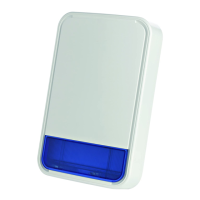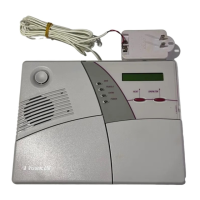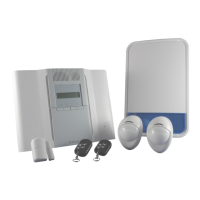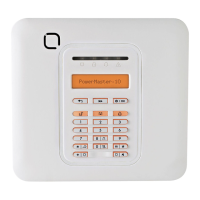18 DE5110
6,56,5(1'5,9(5237,21
'HVFULSWLRQ DQG 8VH
The SIR-1000 module (Fig. 7.1)
is designed to produce a swept
tone siren signal at a power
level suitable for driving a 10
watt / 4 or 8-Ohm loudspeaker.
The module is equipped with a
board-to-board connector for
easy integration with the control
module - it mates with the
connector at the lower right
side of the alarm control
module. Two screw terminals
Figure 7.1 SIR - 1000 Wiring
are provided for connecting a loudspeaker, and an on-board 1.5A
fuse protects the SIR-1000 against short circuits across the
loudspeaker terminals.
0RXQWLQJ
If you wish to add the SIR-1000 to an existing MAESTRO-1600 or
MAESTRO- 1600DL, refer to Fig. 1.1 for module location. Mate the
board-to-board connector on the SIR-1000 with the socket at the
lower right edge of the alarm control module.
Once the connectors are mated, the mounting hole near the
terminal block of the SIR-1000 will be aligned with a stand-off in
the rear wall of the metal cabinet. Use a single screw to fasten the
SIR-1000 to this standoff.
:LULQJ
Terminal Wiring Information
SPK
Loudspeaker Output. Connect a 4Ω/10W
loudspeaker or two 8Ω/5W loudspeakers in parallel
across these terminals.
.(<3$'%86/(1*7+&216,'(5$7,216
3UREOHP $QDO\VLV
When installing the MAESTRO-1600, you must take into account
that the copper wires used to set up the keypad bus have specific
resistance per unit of length, depending on the diameter of the
wire. There is always a distance beyond which keypads (or the
zone expander) will not work properly, due to the voltage drop
along the cable. Keypads are usually "chained" along the bus, and
an example of such "chaining" is shown in Fig. 8.1. In the
configuration shown above, the voltage drop along the bus
depends on the currents drawn by the various units and on the
resistance of the bus wires. Your purpose should be to plan ahead
so that the voltage at the far end of the line will not drop below the
10 V threshold with proper AC supply to the system.
Planning in advance will enable you to obtain a cable of appropriate
gauge for the particular application. You will thus prevent low voltage
problems that may compel you to re-wire the bus.

